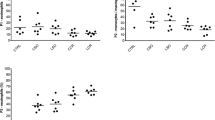Abstract
There is a growing body of evidence that laparoscopic surgery is physiologically less injurious than open surgery. We hypothesized that the open technique results in a greater impairment of peritoneal and systemic defense mechanisms than does the laparoscopic technique. Nissen fundoplication, standardized in technique and duration, was performed in 16 pigs. The procedure was performed through a standard midline incision (OPEN, n=8) or with laparoscopic technique and CO2 pneumoperitoneum (LAP, n=8). The peritoneal cavity was instilled with 400 cc of normal saline, either alone (not contamined, n=8) or containing 109 E. coli/ml (contaminated, n=8). Quantitative cultures, cell count, and flow cytometry were performed on blood and peritoneal fluid samples obtained at timed intervals. We found that host defense processes were better preserved after LAP than by OPEN surgery. Peritoneal and systemic monocyte class II antigen expression, and serum tumor necrosis factor-alpha activity was greater in the OPEN group compared with the LAP group, but peritoneal bacterial clearance was more efficient in the LAP group. These data may illustrate a potential benefit of laparoscopic surgery in cases of peritoneal contamination.
Similar content being viewed by others
References
Bass DA, Parce JW, Dechatelet LR, et al. (1983) Flow cytometric studies of oxidative product formation by neutrophils: a graded response to membrane stimulation. J Immunol 130: 1910–1917
Cheadle WG, Hershman MJ, Wellhausen SR, Polk HC Jr (1991) HLA-DR antigen expression on peripheral blood monocytes correlates with surgical infection. Am J Surg 16: 639–645
Donald RA, Perry EG, Wittert GA, Chapman M, Livesey JH, Ellis MJ, Evans MJ, Yandle T, Espiner EA (1993) The plasma ACTH, AVP, CRH and catecholamine responses to conventional and laparoscopic cholecystectomy. Clin Endocrinol (Oxf) 38: 609–615
Gallinaro RN, Polk HC Jr (1991) Intra-abdominal sepsis: the role of surgery. In: Williamson R, Thompson J (eds) Bailliere's clinical gastroenterology, vol 5. Harcourt Brace Jovanovich, London, pp 611–637
Garcia-Caballero M, Vara-Thorbeck C (1993) The evolution of postoperative ileus after laparoscopic cholecystectomy. A comparative study with conventional cholecystectomy and sympathetic blockade treatment. Surg Endosc 7: 416–419
Hall GM, Desborough JP (1992) Interleukin-6 and the metabolic response to surgery. Br J Anaesth 69: 337–338
Larson GM, Vitale GC, Casey J, Evans JS, Gilliam G, Heuser L, McGee G, Rao M, Scherm MJ, Voyles CR (1992) Multipractice analysis of laparoscopic cholecystectomy in 1,983 patients. Am J Surg 163: 221–226
Lennard TW, Shenton BK, Borzotta A, Donnelly PK, White M, Gerrie LM, Proud G, Taylor RM (1985) The influence of surgical operations on components of the human immune system. Br J Surg 72: 771–776
Mealy K, Gallagher H, Barry M, Lennon F, Traynor O, Hyland J (1992). Physiological and metabolic responses to open and laparoscopic cholecystectomy. Br J Surg 79: 1061–1064
Nystrom PO, Skau T (1983) Elimination patterns of E. coli and Bacteroides fragilis from the peritoneal cavity. Studies with experimental peritonitis in pigs. Acta Chir Scand 149: 383–388
Polk HC Jr, George CD, Hershman MJ, Wellhausen SR, Cheadle WG (1988) The capacity of serum to support neutrophil phagocytosis is a vital host defense mechanism in severely injured patients. Ann Surg 207: 686–692
Roumen RM, van-Meurs PA, Kuypers HH, Kraak WA, Sauerwein RW (1992) Serum interleukin-6 and C reactive protein responses in patients after laparoscopic or conventional cholecystectomy. Eur J Surg 158: 541–544
Schauer PR, Luna J, Ghiatas AA, Glen ME, Warren JM, Sirinek KR (1993) Pulmonary function after laparoscopic cholecystectomy. Surgery 114: 389–399
Schauer PR, Sirinek KR (1995) The laparoscopic approach reduces the endocrine response to elective cholecystectomy. Am Surg 61: 106–111
Vitale GC, Collet D, Larson GM, Cheadle WG, Miller FB, Perissat J (1991) Interruption of professional and home activity after laparoscopic cholecystectomy among French and American patients. Am J Surg 161: 396–398
Wilson RG, MacIntyre IM (1993) Symptomatic outcome after laparoscopic cholecystectomy. Br J Surg 80: 439–441
Author information
Authors and Affiliations
Additional information
Dr. Collet is from the University of Bordeaux, France, and was a visiting Research Fellow
Rights and permissions
About this article
Cite this article
Collet, D., Vitale, G.C., Reynolds, M. et al. Peritoneal host defenses are less impaired by laparoscopy than by open operation. Surg Endosc 9, 1059–1064 (1995). https://doi.org/10.1007/BF00188987
Received:
Accepted:
Issue Date:
DOI: https://doi.org/10.1007/BF00188987




